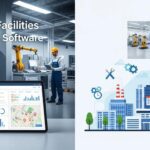Integrating CMMS with IoT, ERP, and DCIM for Holistic Asset Management
I. Introduction: The Connected Future of Asset Management
In today’s rapidly evolving industrial and commercial landscape, organizations are operating in an environment defined by unprecedented complexity. The relentless digital transformation is reshaping every aspect of business, from manufacturing plants and sprawling data centers to vast transportation networks and critical utilities infrastructure. At the heart of this revolution lies the crucial need for effective asset management – ensuring every machine, equipment, and system performs optimally to drive productivity and deliver a superior customer experience.
For years, many companies have relied on a Computerized Maintenance Management System (CMMS) as their core tool for maintenance management. A CMMS excels at tracking work orders, managing inventory, and scheduling upkeep. However, as technology advances, standalone systems often create information silos. The true power emerges not from individual software solutions but from their ability to integrate seamlessly within a larger, unified digital ecosystem.
This blog post will explore how strategic CMMS integration with other vital enterprise software platforms – specifically the Internet of Things (IoT), Enterprise Resource Planning (ERP), and Data Center Infrastructure Management (DCIM) tools – fosters a truly holistic asset management approach. This digital transformation process is not just about adopting new technology; it’s about unlocking profound levels of efficiency, visibility, and intelligence that lead to unparalleled asset performance and a robust competitive advantage.
II. The Imperative for Integration: Breaking Down Data Silos
Different departments often operated with specialized software systems in the past, leading to fragmented information and disconnected business processes. While these individual tools were powerful in their own right, the lack of system integration meant crucial data was often isolated, hindering comprehensive decision-making and overall operational efficiency. This challenge is particularly acute in asset-intensive industries.
A. The Limitations of Disconnected Systems:
When maintenance, finance, and operations rely on separate databases and management systems, several issues arise:
Incomplete Asset Visibility:
- Without CMMS integration with ERP, for instance, the actual cost of an asset, from initial purchase order and procurement to ongoing maintenance and eventual disposal, may not be obvious. This obscures the actual return on investment (ROI) and complicates asset management processes.
- The absence of a holistic approach means management lacks a single source of truth for all asset information.
Inefficient Workflows and Communication Gaps:
- Manual data migration between systems is prone to human error and delays critical business processes.
- A disconnect between maintenance work orders in a CMMS and inventory levels in an ERP can lead to delays in maintenance and repair, increasing downtime.
- Lack of real-time communication between maintenance professionals and operations can result in missed opportunities for proactive intervention or misaligned strategic planning.
Suboptimal Resource Allocation and Risk Management:
- Predictive maintenance efforts are limited without combined data from sensors (IoT) and maintenance history (CMMS), increasing the risk of unexpected equipment failure.
- Forecasting spare part demand or resource needs becomes guesswork without an integrated view of asset health and planned maintenance tasks. This directly impacts the supply chain and its optimization.
- A holistic risk management strategy is challenging without comprehensive data spanning various systems and departments.
B. The Holistic Vision: A Unified Digital Ecosystem:
System integration aims to create a seamless flow of information across the entire organization‘s value chain. This unified digital ecosystem acts as a central nervous system, providing unparalleled visibility and intelligence to all stakeholders.
Enhanced Data Governance and Quality:
- When systems are integrated, data can be synchronized across platforms, improving data integrity and ensuring everyone is working from the most current and accurate information.
- This unified database supports robust data governance frameworks crucial for compliance and sound business decisions.
Streamlined Business Processes and Automation:
- System integration facilitates business process automation, where information from one system automatically triggers actions in another. For example, a sensor detecting a change in condition could automatically create a work order in the CMMS and trigger a purchase order in the ERP if a specific spare part is needed.
- This reduces manual effort, accelerates workflows, and boosts overall operational efficiency.
Improved Strategic Planning and Competitive Advantage:
- With a holistic approach to asset management, leadership can leverage comprehensive analytics and dashboards to inform long-term strategic planning and investment decisions.
- This intelligence provides a significant competitive advantage by enabling better resource management, reduced cost, and enhanced customer satisfaction through consistent uptime and reliable service quality.
III. CMMS as the Central Hub: Integrating with Key Enterprise Systems
A CMMS is inherently designed to manage assets and their maintenance. By integrating it with IoT, ERP, and in specialized cases, DCIM tools, an organization can unlock deeper levels of intelligence and automation, creating a powerful framework for holistic asset management.
A. CMMS and the Internet of Things (IoT): The Foundation of Predictive Maintenance:
The Industrial Internet of Things (IIoT) represents a revolution in asset monitoring. Integrating CMMS software with IoT technology is critical in moving from traditional maintenance practices to truly predictive maintenance. Real-time Condition Monitoring:
- Sensors attached to equipment (from manufacturing machines to HVAC systems and transport fleet management assets) collect real-time data on key parameters like vibration, heat, electricity consumption, pressure, and lubricant health.
- This data is transmitted to the CMMS database, providing continuous condition monitoring of assets.
- This continuous stream of information allows maintenance professionals to understand the exact health of an asset at any given moment, far beyond what manual inspections can achieve.
Enabling Predictive Analytics and Proactive Intervention:
- With IoT data flowing into the CMMS, machine learning algorithms and artificial intelligence (AI) can analyze patterns to perform sophisticated predictive analytics.
- This intelligence identifies anomalies and forecasts potential equipment failure before it occurs. For instance, a subtle change in vibration or temperature might trigger a work order for maintenance in the CMMS automatically.
- This proactive strategy minimizes unscheduled downtime, reduces emergency repairs, and significantly lowers overall maintenance costs, boosting productivity and uptime.
B. CMMS and Enterprise Resource Planning (ERP): Bridging Maintenance and Business Operations:
ERP systems are the backbone of an organization‘s financial, supply chain, and human resource management. Integrating CMMS with ERP (such as Microsoft Dynamics 365 or SAP) creates a powerful link between maintenance operations and core business processes.
Streamlined Procurement and Inventory Management:
- When a work order in the CMMS indicates the need for a specific spare part, the information can automatically trigger a purchase order request or check inventory levels within the ERP system.
- This ensures that the right spare parts are available when needed, preventing delays in maintenance and repair, optimizing inventory levels, and reducing carrying costs across the supply chain.
- This system integration ensures accurate cost tracking for maintenance, providing granular financial services data within the broader ERP context.
Unified Financial Tracking and Asset Lifecycle Management:
- Maintenance costs (labor, parts, tools) can be seamlessly integrated into the ERP‘s financial modules, providing a true picture of the total cost of ownership for each asset.
- This comprehensive data supports better investment management and strategic planning for asset procurement and retirement, enabling more informed asset management strategies.
- Collaboration between maintenance engineers and finance teams becomes effortless, driven by shared data.
C. CMMS and Data Center Infrastructure Management (DCIM): Precision in Critical Environments:
For specialized environments like data centers, CMMS integration with DCIM tools offers a critical level of precision for ensuring near-perfect uptime.
Enhanced Visibility and Capacity Planning:
- DCIM tools provide granular data on power consumption, heat distribution, airflow, and space utilization within the data center.
- Integrating this information with a CMMS allows data center managers to link equipment performance directly to its physical and environmental conditions.
- This combined intelligence supports highly accurate capacity planning, identifying potential hotspots or power limitations before they cause downtime or failure.
Proactive Maintenance for IT Infrastructure:
- CMMS receives alerts from DCIM tools when environmental parameters deviate, automatically creating work orders for air conditioning adjustments or server maintenance.
- Automating maintenance work orders based on real-time IT infrastructure condition monitoring is essential for preventing incidents that could lead to SLA penalties.
- It ensures the reliability engineering principles are applied directly to the unique demands of data center operations.
IV. The Benefits of a Truly Unified Ecosystem: Driving Strategic Growth
The power of CMMS integration with IoT, ERP, and DCIM extends far beyond simply optimizing maintenance tasks. It unlocks a cascade of benefits that propel an organization towards significant business transformation and sustainable growth.
A. Unparalleled Operational Efficiency and Uptime:
A holistic approach to asset management drastically improves operational efficiency.
Minimized Downtime and Increased Productivity:
- Predictive maintenance through IoT data and analytics significantly reduces unscheduled downtime, ensuring continuous productivity on the factory floor or consistent service delivery from data centers.
- Automating work orders and inventory management streamlines maintenance processes, allowing technicians to focus on value-added maintenance work.
Optimized Resource Management:
- Better visibility into asset health and inventory through integrated systems enables optimal resource allocation, from technicians to spare parts and energy consumption.
- This leads to reduced waste, lower cost, and a higher return on investment (ROI) for maintenance investments.
B. Enhanced Data-Driven Decision-Making and Innovation:
The flow of clean, integrated data fuels superior intelligence and strategic innovation.
Actionable Analytics and Dashboards:
- CMMS analytics dashboards, enriched with data from IoT and ERP, provide a comprehensive view of asset performance, maintenance costs, and operational efficiency.
- This data transformation enables management to identify trends, forecast future needs, and make data-driven management decisions for long-term strategic planning.
- This rich information can more accurately inform reliability block diagrams and failure mode and effects analysis (FMEA).
Fostering Digital Business and Competitive Advantage:
- This deep level of intelligence allows organizations to anticipate market shifts, optimize their value chain, and maintain a strong competitive advantage.
- It supports a digital business model where agility and innovation are embedded into every business process. This also helps build a stronger brand image as a reliable service provider.
C. Robust Risk Management and Sustainability:
A connected ecosystem bolsters an organization‘s resilience and commitment to responsible operations.
Proactive Safety and Regulatory Compliance:
- Integrated systems provide comprehensive data for risk management, helping identify potential hazards and ensuring adherence to occupational safety and health (OSHA) standards and other regulatory compliance.
- Process safety management is enhanced through better visibility into equipment health and maintenance schedules.
- A robust audit trail across all integrated software solutions provides transparency for stakeholders and regulators.
Driving Sustainability Initiatives:
- Integrated CMMS and IoT contribute directly to sustainability goals by optimizing energy consumption and reducing waste through efficient maintenance practices.
- This includes better management of electricity and power usage, potentially leveraging renewable energy insights where applicable.
V. Building Your Unified Ecosystem: Practical Considerations
Embarking on a CMMS integration journey requires careful planning and a clear digital transformation roadmap. While the benefits of CMMS are immense, a successful digital transformation depends on a thoughtful strategy.
A. Key Considerations for System Integration:
To ensure a smooth transition and maximize investment, consider these factors:
Interoperability and API Capabilities:
- The selected CMMS, ERP, DCIM, and IoT platforms must offer strong APIs and a flexible architecture to enable seamless interoperability and data sharing.
- Middleware may be necessary to bridge different software systems effectively.
Data Governance and Quality:
- Establish clear data governance policies to ensure data quality and consistency across all integrated systems. This is fundamental for reliable analytics and accurate forecasting.
Scalability and Future-Proofing:
- Choose software vendors that offer scalable solutions that can grow with your organization‘s evolving infrastructure and technological demands. This ensures a long-term return on investment.
Security and Authentication:
- Robust data security protocols, including strong authentication and encryption, are paramount when linking multiple systems that handle sensitive information.
User Adoption and Training:
- A digital transformation initiative is only as strong as its workforce‘s adoption. Provide comprehensive onboarding and ongoing training to ensure technicians, engineers, and management fully leverage the integrated tools and understand the new business process. The interface‘s usability is key.
B. The MicroMain Advantage in a Connected World:
MicroMain understands that effective CMMS integration is pivotal for modern asset management. Our CMMS software is designed to be a flexible and powerful hub within your larger enterprise ecosystem.
MicroMain’s capabilities directly support this integration imperative:
Open API and Flexible Architecture:
- MicroMain CMMS offers robust APIs, facilitating seamless system integration with your existing ERP (including Microsoft Dynamics 365), IoT platforms, and specialized DCIM tools. This ensures smooth data migration and real-time data sharing across your information technology landscape.
Comprehensive Asset Management Core:
- At its heart, MicroMain provides unparalleled asset tracking and maintenance management. It collects granular data on every asset, creating a detailed audit trail of maintenance work orders, inspections, and spare part usage. This becomes the reliable database for your integrated ecosystem.
Powerful Analytics and Dashboards:
- MicroMain’s analytics dashboard aggregates data from its modules and can incorporate information from integrated sensors and ERP systems. This provides a holistic visibility into asset performance, downtime, cost, and resource utilization, empowering management with actionable intelligence for strategic planning and investment.
Mobile Accessibility and User-Centric Design:
- Our intuitive mobile app ensures that plant, factory, or facility technicians can access and input data on any mobile device, improving communication and efficiency. This direct interaction ensures high data quality at the source.
Driving Proactive and Predictive Maintenance:
- By seamlessly incorporating sensor data and leveraging predictive analytics, MicroMain enables organizations to transition to proactive maintenance practices, anticipating equipment failure and optimizing upkeep schedules. This translates directly to reduced risk and increased uptime.
MicroMain connects your maintenance operations with your broader business strategy, enabling a true digital transformation. It’s not just a CMMS; it’s a foundation for a more intelligent, efficient, and resilient future.
VI. Conclusion: The Power of a Unified Maintenance Ecosystem
The ongoing digital transformation is reshaping industries, demanding a sophisticated, interconnected approach to asset management. The days of isolated software systems are giving way to a new era of unified digital ecosystems, where information flows seamlessly, automation thrives, and intelligence drives every decision.
A robust CMMS, which is the central maintenance management hub, is integral to this revolution. Organizations can unlock unprecedented operational efficiency, productivity, and uptime by strategically integrating with IoT for real-time condition monitoring, ERP for comprehensive business process and financial oversight, and DCIM for specialized data center infrastructure control. This holistic approach to asset management is more than just a technological upgrade; it’s a fundamental shift in business model that builds resilience, enhances safety, and secures a significant competitive advantage.
Investing in CMMS integration and fostering a culture of data sharing and collaboration ensures that every asset contributes optimally to the organization‘s revenue and long-term sustainability. This proactive strategy mitigates risk, optimizes cost, and positions businesses to thrive in the complex, digitally-driven landscape of the future. The truly smart manufacturing and industrial digital transformation leaders understand that unifying their maintenance ecosystem is the key to unlocking their full potential.








